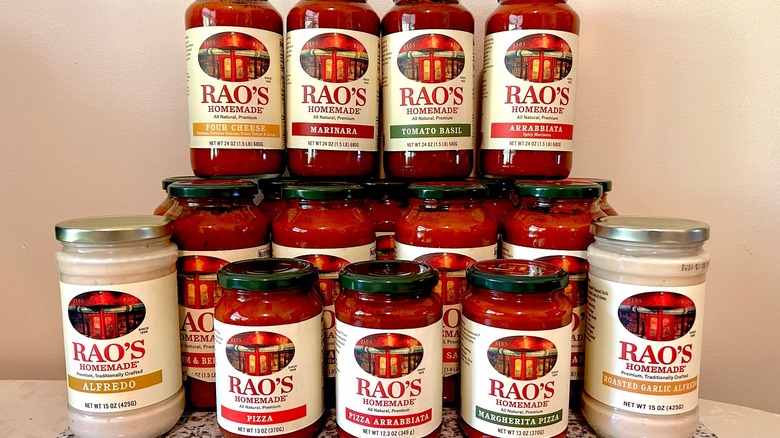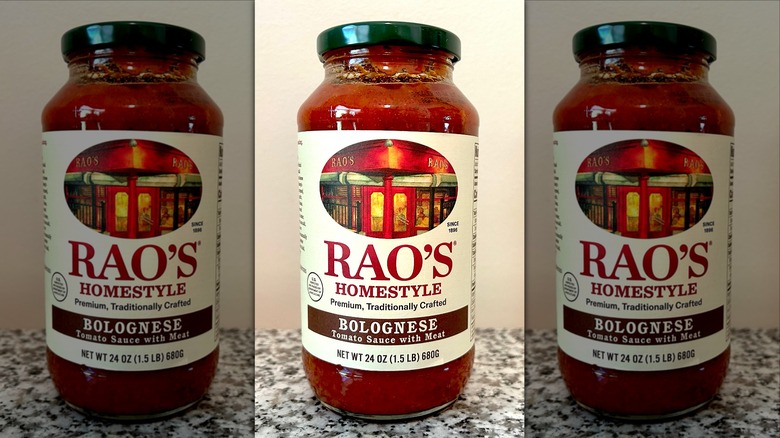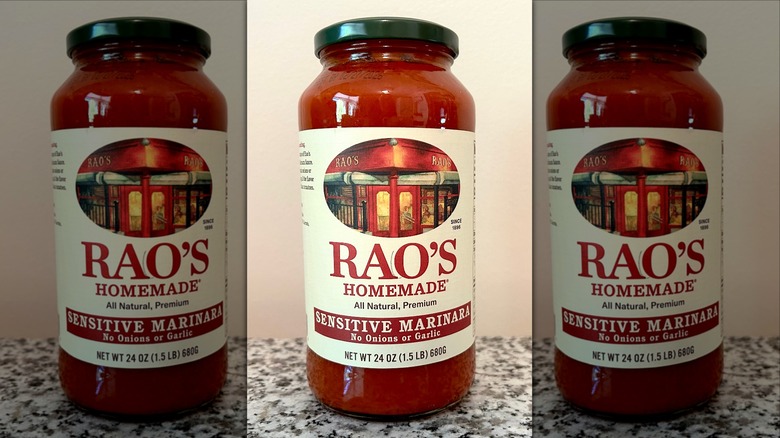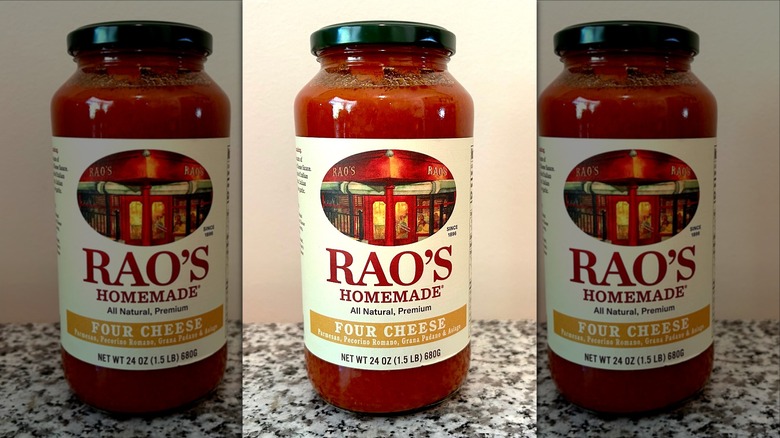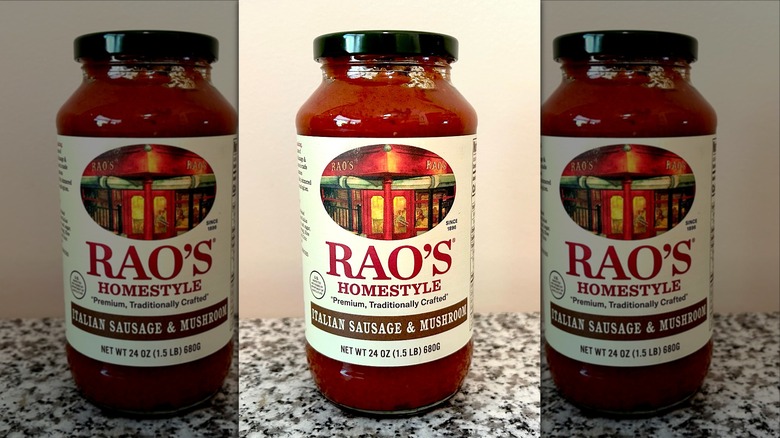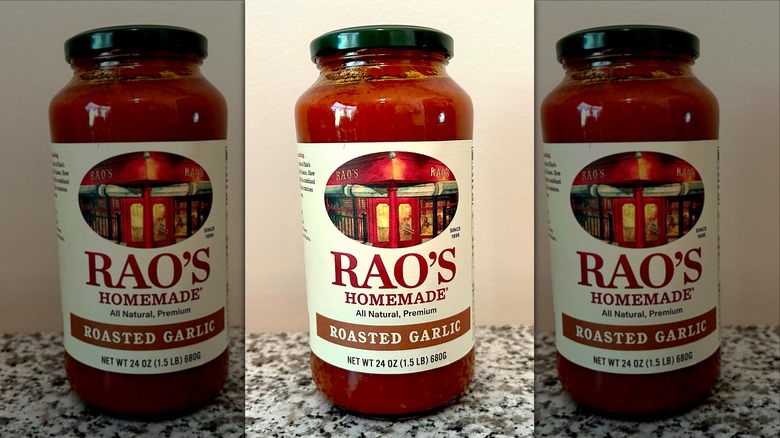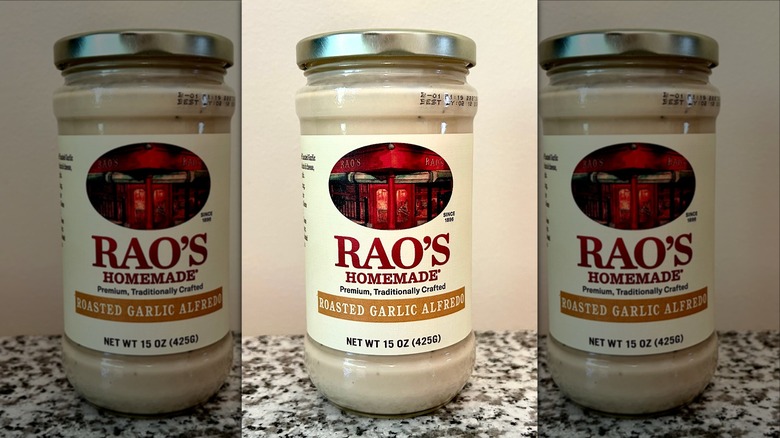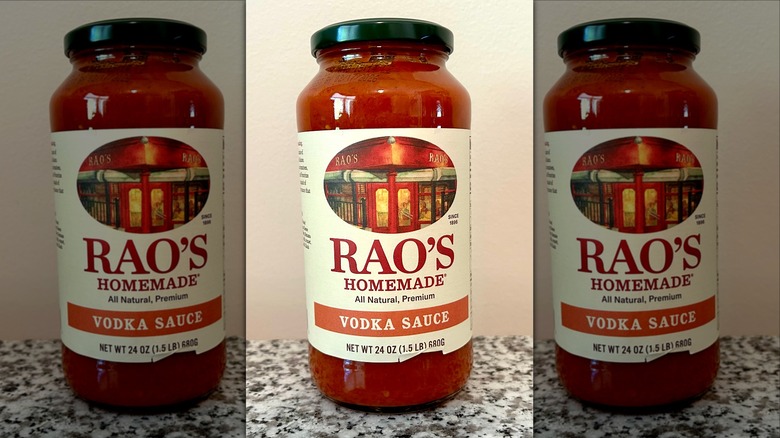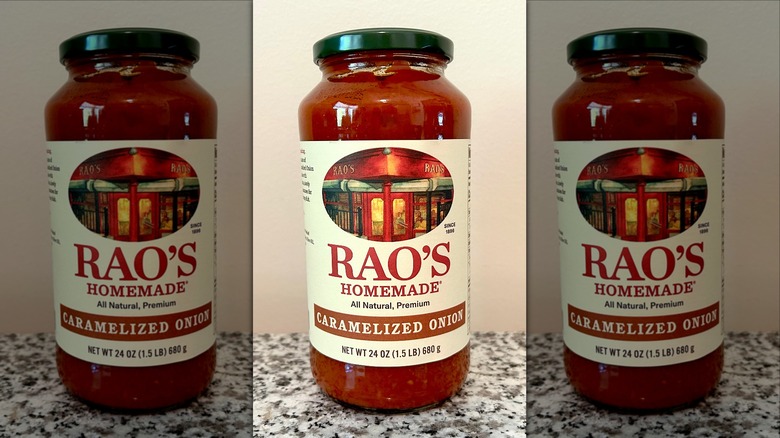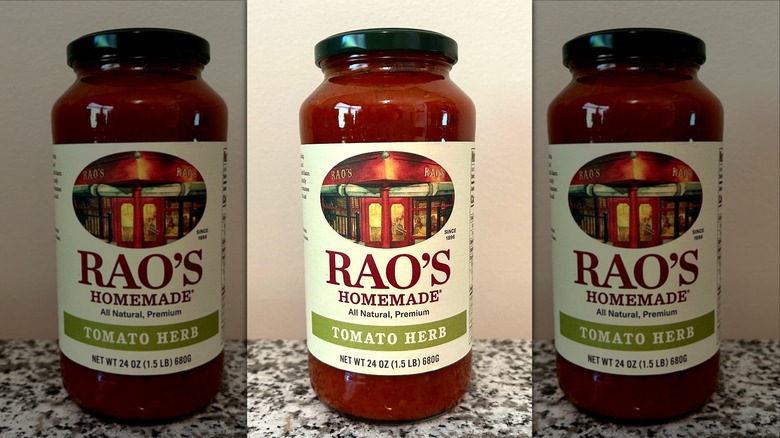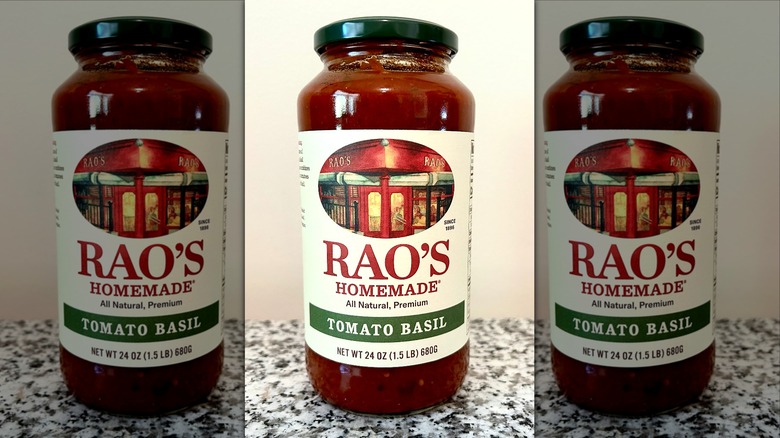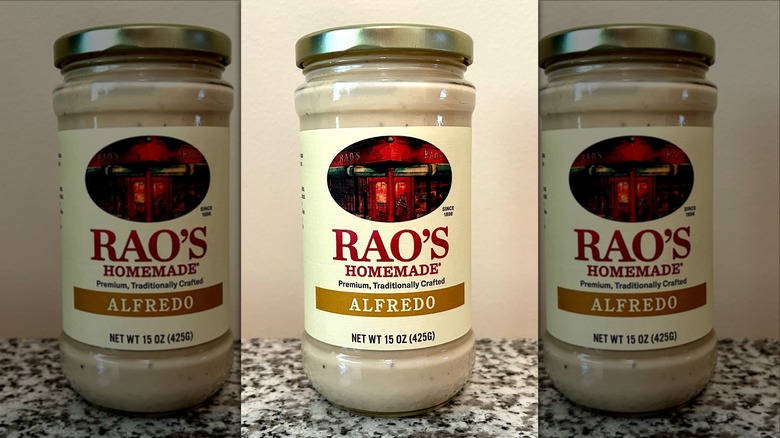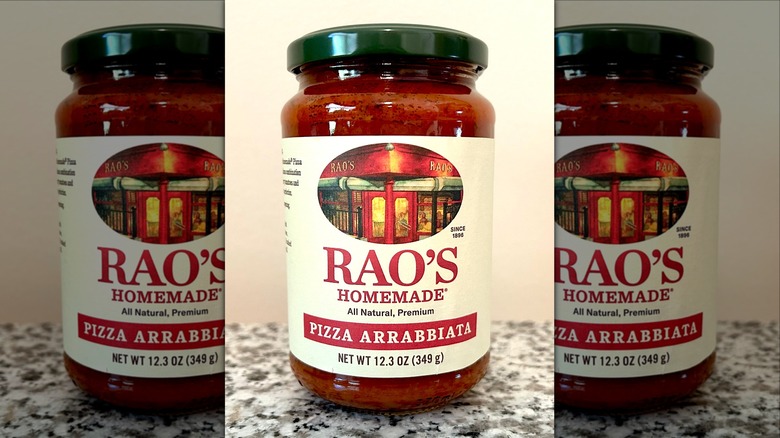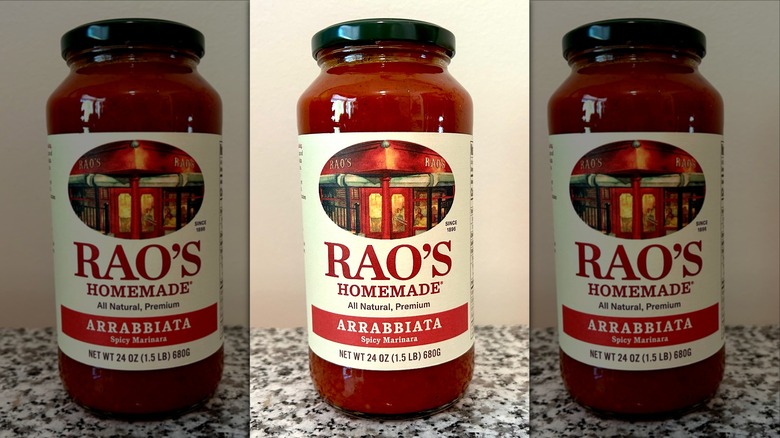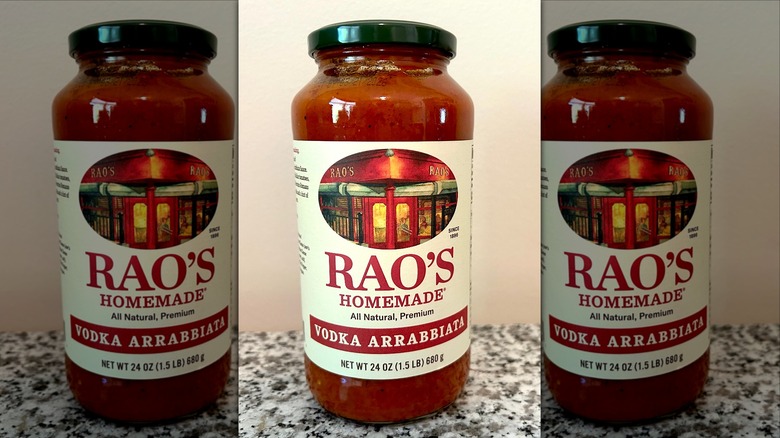18 Rao's Homemade Sauce Flavors, Ranked
Rao's Homemade didn't start with selling jarred pasta and pizza sauces. Its humble origins began in 1896 with founder Charles Rao, an immigrant from Polla in southern Italy. That year, he invested in his first restaurant venture in New York City, the legendary Rao's. Over the next century, Rao's would gain notoriety with its simple, homemade authentic Italian cuisine, which garnered it a 3-star review in 1977 from legendary New York Times restaurant critic Mimi Sheraton.
It began selling its sauces in 1992 when then manager Frank Pellegrino Sr. recognized there was a demand for an Italian sauce product with no frills or fuss, just quality ingredients slow-cooked with patience and care. Since then, the empire has expanded to include multiple restaurant locations and all varieties of Italian fare, from pasta to soups to frozen pizza, but the sauce has remained the central superstar of this brand.
But is it worth it, you might ask? At $4.99-$8.99 a jar, Rao's is a bit more expensive than some of its saucy competitors on the market. Our answer based on sampling 18 different varieties is an unequivocal yes. This may not be your everyday sauce for a quick weeknight spaghetti for the family. But, for a gourmet dish or a specialty recipe, like a classic lasagna, you cannot beat the quality of these sauces. Though it was a challenge, we did rank the sauces from least to most favorite, although they were all spectacular.
18. Homemade Bolognese Sauce
As we mentioned, selecting our least favorite sauce was a challenge; all these sauces had fabulous flavor. In our estimation, this sauce was less reflective of an authentic bolognese than a quality tomato meat sauce. Those are not the same. Most of the best bolognese begin with a soffritto of carrots, onions, and celery to which ground beef, pork, and pancetta are added. And though tomatoes do feature in the sauce, they are not the dominant ingredient.
The final product should be a rich, thick, meat-forward sauce with little liquid and few frills. This sauce was quite tomato-forward, and the meat was less finely ground than is often the case with a bolognese. Again, that may sound nitpicky, but we had to be selective to determine a hierarchy of sauces. Since Rao's prides itself on authenticity, this isn't its best example.
17. Sensitive Marinara Sauce
What we love about this sauce is also what ended up placing it toward the bottom of an esteemed list. This sauce is made without onions or garlic and contains less sodium than the Homemade Marinara sauce — 330 milligrams versus 420 milligrams. The ingredients in this sauce are pure and simple, containing tomatoes, olive oil, carrots, salt, celery, and basil. For those who have difficulty digesting tomato sauce due to its acidity or the alliums, this may be the one sauce your sensitive tummy would tolerate, which is a win in our book.
That said, it did lack some of the complexity of the other sauce flavors. We also found it quite a bit sweeter than the regular marinara, even though the ingredients do not indicate added sugar. That said, there is nothing wrong with this sauce. It's just okay, comparatively.
16. Four Cheese Sauce
The Four-Cheese Sauce is another variety made without garlic or onions. The stars of this are the four cheeses, namely parmesan, Romano, Grana Padano, and Asiago. As cheese lovers, we anticipated loving this flavor more than the rest. It isn't that we didn't enjoy it, but we found its flavor to be somewhat bland.
The fact that the dominant ingredient is cheese would suggest that this would be a saltier sauce, but that wasn't the case. We found that it needed a touch more salt to balance out the sweetness of the tomato base. It also lacked some acidity, which might have punched up the flavor. What we enjoyed about this sauce was how well it coated the pasta we sampled it with. We used fusilli and linguini. It luxuriously bathed each well, giving you a nice mouthful with every bite.
15. Mushroom & Bell Pepper Sauce
If you love mushrooms and peppers, you will love this sauce. This sauce was replete with big slices of mushrooms and chunks of mostly green peppers. The mushrooms had a somewhat chewy texture but were not overly squishy, which is a common complaint. The peppers, though properly cooked, may make this sauce challenging to digest for those with sensitive stomachs.
The overall flavor of the sauce itself was rich, with lots of caramelized onions, garlic, basil, oregano, crushed red pepper flakes, and white wine. We thought the balance of acidity, sweetness, and salt was spot on in this sauce, with just a hint of heat to give it some complexity. It reminded us of a pizzaiola sauce, which frequently contains olives and capers and gets served atop a steak or pork chop.
14. Italian Sausage and Mushroom Sauce
We ranked the Italian Sausage and Mushroom Sauce here for the same reason as the Mushroom and Pepper variety. Mushrooms are often an acquired taste, and many dislike their texture. The mushroom pieces in this sauce are pronounced. We love them, but anyone who disapproves of them will find that unappealing. In addition, there are big chunks of a delicious, tender, finely seasoned sausage loaded with paprika, garlic, and fenugreek.
The tomato sauce has a harmonious blend of acidity to sweetness and is not overly salty. The basil and oregano are also prominent, giving this a well-rounded umami-forward flavor. Because this is a thicker textured sauce, this would pair best with a wide flat noodle, like tagliatelle, or tubular pasta, like penne, ziti, or rigatoni. These pasta types are much more likely to hold onto the sauce without getting drowned under it.
13. Rao's Roasted Garlic Sauce
The roasted garlic flavor isn't always everyone's cup of tea. We happen to be garlic gluttons, putting it into virtually any meal but understand that it can cause stomach upset for some. Others may want to forgo an aggressively garlic-flavored meal to help preserve the romance on a first date. For that reason, we ranked this sauce here. The garlic is pervasive, even if it is perfectly roasted, sweet, and caramelized.
The sauce is somewhat thinner than the others we tried, similar to the classic marinara. It had a mild acidity and was not overly sweet, even though we also didn't detect as strong a tomato flavor as some other varieties. This was a robust sauce without a lot of complexity. We'd pair it with homemade eggplant or chicken parmesan. The fresh mozzarella would be delicious juxtaposed with the prominent garlic aroma and flavor.
12. Roasted Garlic Alfredo Sauce
Keeping with a trend, the sauce next on our ranking is the Roasted Garlic Alfredo, which we loved. The sweet, rich roasted garlic flavor is an asset to an alfredo sauce, giving it far more complexity. That said, we understand it is not a preferred flavoring for everyone.
For someone accustomed to a thick, floury alfredo that you might find at an Americanized Italian restaurant, you might find the texture of this sauce foreign. It is light and creamy but not pasty. It has a beautiful smokiness and yet is not overly salty.
We also noted that while it does not explicitly state that it is gluten-free, flour is not listed on the ingredients, nor does the required FDA allergen labeling state that wheat is included. It only mentions eggs and milk. That's amazing for those who have avoided Alfredo sauces due to gluten allergies.
11. Homemade Vodka Sauce
This sauce can best be described as an umami bomb. It tastes like it has meat in it, yet it does not. That is a result of the parmesan and Romano cheeses, which perfectly balance the hint of sweetness conferred by the vodka in which this sauce simmered. Sometimes vodka sauces can be very sharp and acidic. This one is smooth as silk. It has a balanced level of acidity, is not overly salty, and is well-rounded with hints of onion, garlic, basil, and oregano.
Though a classic vodka sauce is served with penne, you could top this over any tubular-shaped pasta. If you would like to add meat to it, we recommend going subtle so as not to overwhelm the nuance of the sauce. Baked or grilled chicken, shrimp, or a seared salmon filet would be ideal.
10. Margherita Pizza Sauce
It may seem like comparing apples to oranges to mix pizza and pasta sauces in one ranking, but they aren't as dissimilar as you might think. In many aspects, they can be used interchangeably and often are. Marketing them as something different is clever, but you could easily substitute a marinara for a margherita pizza sauce, and the two tasted remarkably similar.
Rao's Homemade Margherita Pizza sauce was the thinnest of the three we sampled. It had a bright, fresh flavor, containing whole peeled and cherry tomatoes. The acidity was present but not overwhelming. It was sweet but not overly so. The basil and oregano were prominent in this sauce, and its salt content was spot on. We could see why this sauce would marry perfectly with fresh mozzarella and basil in a classic margherita pizza. It was the mildest of the pizza sauces we tasted.
9. Homemade Marinara Sauce
As far as a basic Marinara is concerned, you probably won't get much better out of a jar than this one unless you make it from scratch with tomatoes from your garden. The texture had nice chunks of tomato and a bright red hue. Its flavor was an ideal balance of acidity with no residual sweetness. There wasn't much-added salt, which we appreciated.
Although the ingredients include onions, garlic, basil, and oregano, these are not particularly prominent in the sauce. We probably prefer a more aggressive seasoning in our marinara, but this would be the perfect sauce for a simple pasta dish for most individuals. You could easily use it for a homemade lasagna if you didn't feel like making your sauce or as a substitute for the Margherita Pizza Sauce if you didn't want to purchase both. Their flavor profiles and textures were very similar.
8. Caramelized Onion
We are big French onion soup fans, which means this sauce was right up our alley. It is chock full of big chunks of perfectly caramelized onions, which is no small feat to accomplish. Properly caramelizing onions without burning them is an art form that takes time and a low cooking temperature. When done correctly, the onions become sweet, which gives this sauce a distinct flavor and texture.
This sauce also had a nice balance of salt without being overwhelming. And the acidity of the tomatoes was tempered by the sweetness of the onions. This would be a stellar sauce to serve with meatballs or meatloaf. That said, we do recognize that not everyone likes onions. For this reason, we didn't rank this sauce higher, but this was a winning sauce for our palates.
7. Tomato Herb Sauce
The Tomato Herb Sauce was slightly more to our liking than the regular marinara. It had a much more nuanced and complex flavor conferred by the oregano and basil, which shine in this sauce. It is also somewhat less tomato-forward, which tempered the acidity. For those with sensitive stomachs, that is a plus. This sauce was also perfectly seasoned, not too salty, but just enough to accentuate the herbs.
The texture of this sauce was perhaps just a touch less chunky than the marinara, but you could still detect the whole peeled tomatoes. We also liked that you can see the herbs in the sauce, which indicates that they used enough to give it a more prominent flavor. For an everyday sauce, this would be a good standby to have on hand.
6. Homemade Pizza Sauce
As noted earlier, pizza and pasta sauces could be used interchangeably, which explains why we include them in this ranking. Rao's Homemade Pizza sauce was just a touch thicker than the margherita one. It also had more noticeable tomato chunks, which are lovely on a pizza. The use of Italian whole peeled tomatoes and cherry tomatoes gives this sauce a tad more complexity in flavor.
The balance between acidity and sweetness is spot on, with just enough salt to round things out. The basil and oregano are also quite prominent in this sauce. In many ways, it has many of the same elements as the tomato herb sauce but is a bit thicker. We recommend using this sauce with a meaty pizza, particularly salty ones like prosciutto, pepperoni, or sausage.
5. Homemade Tomato Basil Sauce
The ingredients in Rao's Homemade Tomato Herb and the Tomato Basil sauces are similar but listed in different orders, with the omission of carrots in this one. Yet, the flavors are distinct, with this sauce having an almost umami-like quality even though it does not contain meat or cheese. It is a robust sauce with perfect acidity that oozes fresh tomato when you first taste it, yielding subtly to the fresh basil flavor. It is also not overly salty.
The texture of this sauce is also more homogenous, although rich, with small chunks of basil visible throughout. We'd recommend this as a substitution for homemade sauce in a lasagna, as it would complement the meat and ricotta filling. It would also be fabulous in an eggplant or chicken parmesan recipe.
4. Homemade Alfredo Sauce
This Alfredo sauce is a home run. We can safely say it is one of the best we have ever tasted. Not only does it have a delicious cheesiness conferred by the parmesan and Romano, but it also has the perfect balance of salinity, which can sometimes be challenging to obtain with cheese-based sauces. Most end up being a bit heavy-handed in the salt department.
This sauce shines in its texture. It is creamy but not pasty, the way many Alfredos can be, particularly those thickened with flour. Yet again, we noted that though there is no indication that this is specifically gluten-free, the ingredients would suggest it is. Additionally, the allergen label only specifies eggs and milk, not wheat. We sampled this sauce with linguini. It coated the noodles beautifully, wrapping each delicately without overwhelming the pasta.
3. Pizza Arrabbiata
In our home stretch, we end our top picks with the three variations of Arrabbiata we sampled. Arrabbiata is an Italian word that translates to angry, referencing the spiciness of this type of sauce. Crushed red pepper flakes contribute to the heat in this sauce. The pizza variation of this sauce was slightly thicker than the other two, probably added by the carrots that appear on the ingredients list of this variety but not the others.
The flavor of this sauce is rich and round. There is an umami quality that helps to balance out the heat from the chilis somewhat but do not let that fool you — it is a spicy sauce. For this reason, it may be a bit of an acquired taste. We would temper the heat of this sauce with fresh mozzarella and roasted vegetables for a divine pizza.
2. Rao's Arrabbiata Sauce
As noted, the regular Arrabbiata sauce did not contain carrots, making its texture somewhat thinner than the pizza variety. Yet it is still a thicker sauce than most of the others we sampled. It has the flavor of fresh tomatoes without the acidity. It also has no residual sweetness and is perfectly salted.
The spice is the dominant flavor in this sauce, muting any of the herbs, onions, or garlic. These aromatics contribute a rich earthiness that makes this sauce taste almost meaty. As tomato-based sauces go, this one tended to cling to the pasta we sampled it with better than some of the others. To offset some of the heat, we'd garnish this with some freshly grated parmesan or Romano cheese.
1. Vodka Arrabbiata
And the winner of our favorite Rao's sauce is the Vodka Arrabbiata. Again, this is not to diminish any of the other sauces, which were all stellar, but there was something special about this one. The combination of the spicy red pepper flakes with the salty parmesan and Romano cheeses simmered in vodka is a home run. As with the other vodka sauce, the alcohol confers a hint of sweetness to balance out the acidity of the tomatoes.
This sauce is rich and velvety in texture. And while it is somewhat spicier than the regular Arrabbiata, we found it pleasant, not overwhelming. Our litmus test for spiciness is whether the heat accentuates the other flavors of the sauce without muting our taste buds. This sauce accomplishes this in spades. For those who enjoy a hint of spice with a complex flavor, this sauce is for you.
